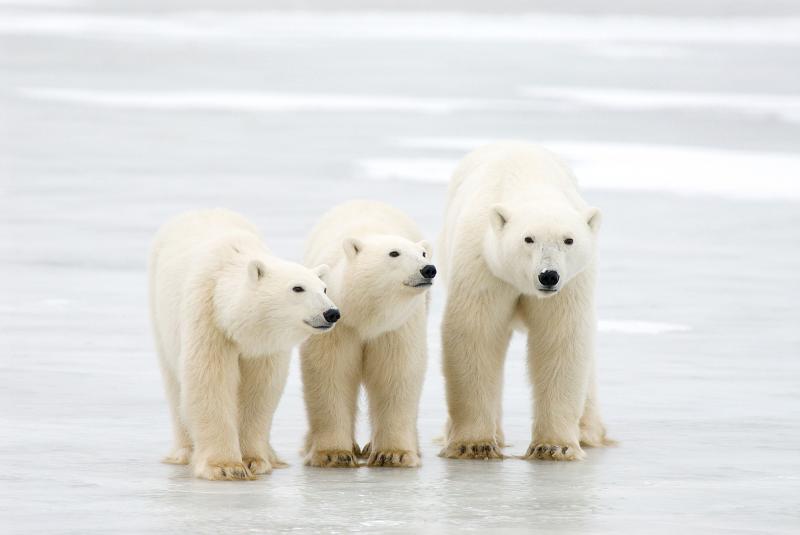Scientists have predicted for the first time when, where and how polar bears are likely to disappear, warning that if greenhouse gas emissions stay on their current trajectory all but a few polar bear populations in the Arctic will probably be gone by 2100. By as early as 2040, it is very likely that many polar bears will begin to experience reproductive failure, leading to local extinctions, according to a study published in Nature Climate Change.
The study examines how the bears will be affected under two different greenhouse gas emissions scenarios. The researchers found that under a business-as-usual emissions scenario, polar bears will likely only remain in the Queen Elizabeth Islands — the northernmost cluster in Canada’s Arctic archipelago — at the end of the century. And even if greenhouse gases are moderately mitigated, it is still likely that the majority of polar bear populations in the Arctic will experience reproductive failure by 2080.
Scientists estimate that there are fewer than 26,000 polar bears left, spread out across 19 different subpopulations that range from the icescapes of Svalbard, Norway, to Hudson Bay in Canada to the Chukchi Sea between Alaska and Siberia. Polar bears are unable to find enough sustenance on land and rely on sea ice from which to hunt. They often stake out seal breathing holes in the ice, waiting hours for a blubbery meal to break the surface. But as that sea ice declines because of climate change, so, too, will the polar bears.

Photo: Polar Bears International via AFP 照片:法新社/國際北極熊組織
“It’s been clear for some time that polar bears are going to suffer under climate change,” said Peter Molnar, a biologist at the University of Toronto Scarborough, and lead author of the study. “But what was not fully clear was when we would expect major declines in the survival and reproduction of polar bears that could ultimately lead to their extirpation. We didn’t know whether that would happen early or later in this century.”
Polar bears draw on energy reserves built up during the winter hunting season to make it through lean summer months on land or time spent on ice in unproductive waters. Though the bears are used to fasting for months, their body condition, reproductive capacity and survival will eventually diminish if they are forced to go too long without food. In Alaska’s southern Beaufort Sea population, biologists have already seen polar bear numbers drop 25 to 50 percent during low ice periods when the bears have been forced to fast for too long. And in western Hudson Bay, one of the southernmost polar bear habitats, the population has declined by roughly 30 percent since 1987.
To figure out when bears might reach their critical physiological limit, Molnar and his colleagues estimated how thin and fat polar bears can be and modelled the animals’ energy use to derive the threshold number of days they can fast before cub and adult survival rates decline. Then they combined those thresholds with the projected number of future sea ice-free days to determine how populations will be affected in different parts of the Arctic.
The study examined 13 of the world’s 19 polar bear subpopulations, accounting for 80 percent of the total population of the species. Of those studied populations, polar bears in southern Hudson Bay and Davis Strait in Canada are “very likely” to experience reproductive failure by 2040 in a scenario of unmitigated emissions. Polar bears in much of Alaska and Russia will be in serious trouble by 2080. And by 2100, it’s inevitable that these populations will experience reproductive failure, leading to extinction if countries don’t drastically reduce emissions of heat-trapping gases.
“It’s important to highlight that these projections are probably on the conservative side,” said Steven Amstrup, chief scientist for Polar Bears International and a co-author of the study. The models, he explained, may assume a better-than-reality body condition of the bears at the start of fasting periods. And the team used a cautious baseline estimate for how much energy a bear uses to maintain its body condition. “The impacts we project are likely to occur more rapidly than the paper suggests.”
It’s important that the public understand the urgency of the issue, Amstrup said. But a timeline for possible extirpation was also an important tool for managers in northern communities living alongside polar bears. “It shows where we would expect to see increased human-bear conflict,” said Andrew Derocher, a biology professor at the University of Alberta who is unaffiliated with the study. Not all Arctic communities have programmes in place to deal with more polar bears in their localities. And there is a moral question of whether humans should help struggling bears.
(The Guardian)
科學家首次預測出北極熊會在何時、何地,以及如何消失在世界上,並提出警告:如果溫室氣體排放曲線仍然維持目前的軌跡,北極圈內除了少數群體,絕大多數北極熊都可能在二一○○年前消失。這份發表於期刊《自然氣候變遷》的研究指出,最快在二○四○年,許多北極熊就會開始無法延續後代,導致局部地區滅絕。
這份研究檢驗兩種不同溫室氣體排放情境可能對北極熊造成的影響。研究人員發現,在「一切如常」的排放情境下,到本世紀末時,北極熊可能只會存活於加拿大北極群島中最北的伊麗莎白女王群島。而就算溫室氣體稍微緩和,北極圈內大多數的北極熊群體仍可能在二○八○年之前喪失繁殖能力。
科學家估計目前野外僅存不到兩萬六千隻北極熊個體,分散為十九個不同子群體,各自分布於挪威斯瓦巴群島、加拿大哈德遜灣,以及阿拉斯加和西伯利亞之間的楚科奇海等冰天雪地中。北極熊無法在陸地上找到足夠的糧食,必須仰賴海冰,在冰上狩獵。牠們經常監視海豹在冰面上的呼吸孔,花費數個小時等待肥美的大餐自己擊破冰面送上眼前。只是,隨著海冰因為氣候變遷而減少,北極熊數量也節節下滑。
該研究的主要作者、多倫多大學士嘉堡校區的生物學家彼德‧莫納爾表示:「好一段時間以來,人類很清楚北極熊將遭受氣候變遷帶來的負面影響。」他指出:「但是之前不完全明朗的是,北極熊的生存和繁殖情況預計會在何時出現大規模衰退,最終導致牠們完全滅絕。我們先前不清楚這會在本世紀前期還是晚期發生。」
北極熊仰賴冬天狩獵季節累積的能量儲備,才能在陸上度過貧乏的夏季月份,或是撐過在貧瘠海域的冰上消耗掉的時間。儘管牠們習慣數個月不進食,但是如果被迫處於毫無食物的情況太久,北極熊的身體狀況、生殖能力以及存活率最後都會降低。在阿拉斯加波弗特海南部的群體中,生物學家已經注意到,北極熊因為被迫禁食太久,數量在融冰時期下滑了百分之二十五到五十。在哈德遜灣的西部地區,也是北極熊最南端的棲息地之一,族群數量自一九八七年以來約衰退了百分之三十。
為了找出這種動物何時會達到危急存亡的生理極限,莫納爾和他的同事估算出北極熊最胖和最瘦的可能性,並且以這種動物的能量消耗建立模型,導出成年北極熊和幼崽最多能禁食幾天而不會造成存活率下降的門檻日數。接著,他們再將這個門檻日數和未來無海冰的估算日數結合,以判定北極圈不同地區的北極熊群體會受到什麼影響。
這篇研究檢驗了全球十九個北極熊子群體中的十三個,佔該物種總數的百分之八十。在這些研究對象中,加拿大南哈德遜灣和戴維斯海峽的北極熊──在溫室氣體排放未減緩的情境下──「非常可能」在二○四○年以前喪失繁殖能力。阿拉斯加和俄羅斯的大多數北極熊則會在二○八○年以前陷入重大危機。如果世界各國沒有大幅度減低吸熱氣體的排放量,到了二一○○年,這些北極熊群體都會無可避免地遭遇繁殖衰退問題,導致物種滅絕。
該研究的共同作者、國際北極熊中心的首席科學家史蒂芬‧安斯特拉普表示:「要特別強調的是,這些預測算是相對保守的。」他解釋說,這些模型可能預設北極熊在禁食期開始時,擁有比實際情況更好的身體狀態。而且,在估算一隻熊為了維持身體狀況需要用到多少能量時,研究團隊採用的是相當謹慎的基線。安斯特拉普指出:「我們預測出來的衝擊可能會比論文顯示的還要更快發生。」
安斯特拉普表示,讓大眾了解這個議題的急迫性是相當重要的。不過,對於北極圈內、生活在北極熊身旁的社群而言,北極熊恐將滅絕的時間軸對社群管理者也是很重要的工具。加拿大亞伯達大學的生物教授安德魯.狄洛徹並未參與研究,但他表示:「研究結果告訴我們,哪裡可以預期更多人與熊之間的衝突發生。」並非所有極圈內的社群都有制訂計畫,以應對當地可能移入的北極熊。另外,人類是否應該對挨餓的北極熊伸出援手,這也是一個道德問題。
(台北時報章厚明編譯)